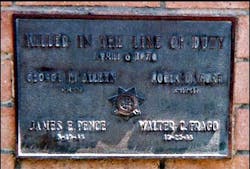April 6, 1970
Recently, while driving home from Los Angeles, I stopped at the Newhall CHP Office, located at 28648 The Old Road, in Valencia. I've traveled past the location along Interstate 5 numerous times over the years, each time vowing that I would stop the next time. I was more motivated than usual this time because I had recently determined that there were actually officers in my department (in Northern California) who had never heard of the infamous Newhall Incident and I was determined to educate them.
As I pulled into the parking lot, I observed a small brick monument with a plaque dedicated to the officers killed in the line of duty on April 6, 1970. Behind the monument were four tall cypress trees, representing each of the officers killed. While photographing the monument, I felt an overwhelming sense of gratitude to Officers George Alleyn, Walt Frago, Roger Gore, and James Pence, none of whom lived to see their 25th birthday.
During my studies, I've read books and seen video reenactments of the Newhall Incident. While I don't intend to retell the story here, my intent in writing this column is twofold. First, I'll offer a very brief overview of the incident, along with some resources for those interested in obtaining more information about what happened in Newhall on April 6, 1970. Secondly, and of even greater importance, I hope to illustrate how the deaths of four young Highway Patrolmen led to improved tactics and training methods that are still prevalent 37 years later.
The Newhall Incident (Summary)
Officer Frago and Officer Gore were dispatched to a reported brandishing of a firearm. They spotted the suspect vehicle and called for backup. While conducting a traffic stop of the vehicle, the driver was instructed to exit and place his hands on the vehicle. Officer Gore approached the driver, while Officer Frago moved to the passenger side of the suspect vehicle. The passenger door swung open suddenly and a suspect, later identified as Jack Twinning, exited and fired at Officer Frago. Officer Frago fell with two shots in his chest. Twinning then fired at Officer Gore, who returned fire. The driver, later identified as Bobby Davis, then shot Officer Gore twice at close range. Both officers were killed instantly.
When backup Officers Pence and Alleyn arrived, they were immediately fired upon by Twinning and Davis. Officer Pence exited and positioned himself behind the passenger door of the patrol vehicle. Officer Alleyn armed himself with a shotgun and took cover behind the driver door of the patrol vehicle. Officers Pence and Alleyn were killed in the ensuing gun battle with Twinning and Davis, who were heavily armed.
Twinning and Davis escaped and fled in separate directions. Twinning entered a residence and took a hostage. With officers surrounding the residence, Twinning killed himself (too bad he didn't do it on April 5, 1970) with the shotgun he stole from one of the officers he killed. Davis was captured and later convicted of four counts of capital murder.
Firearms Issues
I've read conflicting accounts with regard to the use of firearms during the Newhall Incident. Some of the information indicated there were spent shell casings in the pockets of the slain officers, suggesting that they were "policing their brass" as they had done in training at the range, to avoid having to bend over and pick it up at the end of the day. However, John Anderson, in his book, The Newhall Incident: America's Worst Uniform Cop Massacre, dismisses the notion that officers had spent shell casings in their pockets.
All of the accounts I've studied describe one of the officers as having ejected live rounds from the chamber of the shotgun during the incident. Even more tragic was the fact that he was said to have been in position to make a significant difference in the outcome of the encounter. Obviously, the officer ejecting live shotgun rounds is a sign of inadequate training. The officers had reportedly received only brief familiarization training with the shotgun prior to the incident. Coincidentally, the suspects were said to have practiced firing their weapons in the desert just hours before the fateful stop.
Whether you believe the "policing the brass" theory or not, the training that the officers killed in the Newhall Incident received pales in comparison to modern training methods. We now realize the importance of shooting at moving targets, in low-light conditions, while moving, from behind cover, etc. Another significant advancement in firearms training has been the development and implementation of marking cartridges. Engaging in force-on-force scenarios using marking cartridges enables us to actually experience (to some degree) the physiological effects of a real gunfight, including fight or freeze response, elevated heart rate, decreased coordination, tunnel vision, auditory exclusion, etc.
Tactical Issues
The Newhall Incident single-handedly led to the development of what is commonly referred to as the "high risk" traffic stop. There was speculation that since brandishing a firearm was a misdemeanor, Officers Gore and Frago did not conduct a "felony stop," which would have involved calling the occupants out of the vehicle, one at a time, from a position of cover. Instead, they approached the vehicle with less caution.
This incident, perhaps more than any other, encouraged departments to provide a comprehensive training program for recruits as well as in-service officers. In fact, many credit the Newhall Incident as being the catalyst for the widespread use of the term, "officer safety."
Conclusion
Let us not forget Officers Alleyn, Frago, Gore, and Pence. These heroes paid the ultimate sacrifice on April 6, 1970 in Newhall. Their deaths led to the development of tactics that would eventually save the lives of countless officers worldwide. So, the next time you're passing through Newhall, pay your respects to the "Newhall Four," and thank them for the quality tactical training you've received.
Train hard and stay safe!
